Strategic Project Management: Borders Group Inc. Case Study Analysis
VerifiedAdded on 2020/02/24
|13
|3365
|248
Report
AI Summary
This report provides a comprehensive analysis of Borders Group Inc.'s strategic project failures, examining the company's downfall through the lens of strategic project management principles. The report begins with an executive summary and background on Borders Group Inc., highlighting its initial success and subsequent decline due to strategic missteps. It then discusses the application of standard criteria, including SWOT, PESTLE, and Porter's Five Forces analyses, to identify the key factors contributing to Borders' failures. The analysis focuses on the company's weaknesses, such as its failure to adapt to online marketing trends and customer demands, as well as missed opportunities. The report critically identifies and justifies the criteria used, providing a detailed SWOT analysis to pinpoint the company's strengths, weaknesses, opportunities, and threats. The core of the report is a critical analysis of the case based on the chosen criteria, which includes the selection of top management, embracing technological advancements, and transitioning from a product-centric to a customer-centric approach. Conclusions are presented, emphasizing the importance of an efficient management team, continuous environmental analysis, and customer-focused strategies. Finally, the report offers specific suggestions and recommendations for how Borders could have avoided its project failures and thrived in a changing market. The report concludes with a summary of the key findings and insights.
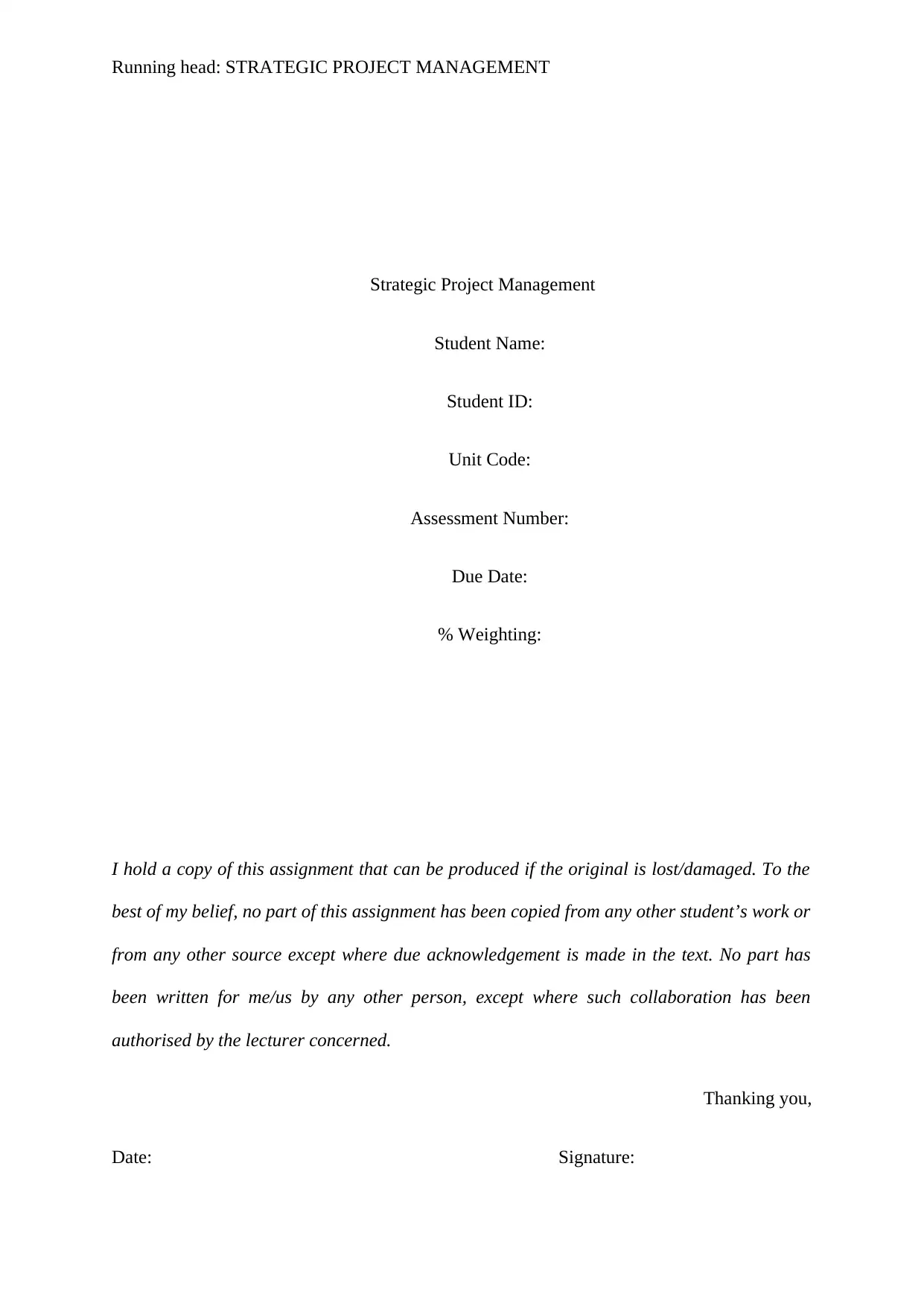
Running head: STRATEGIC PROJECT MANAGEMENT
Strategic Project Management
Student Name:
Student ID:
Unit Code:
Assessment Number:
Due Date:
% Weighting:
I hold a copy of this assignment that can be produced if the original is lost/damaged. To the
best of my belief, no part of this assignment has been copied from any other student’s work or
from any other source except where due acknowledgement is made in the text. No part has
been written for me/us by any other person, except where such collaboration has been
authorised by the lecturer concerned.
Thanking you,
Date: Signature:
Strategic Project Management
Student Name:
Student ID:
Unit Code:
Assessment Number:
Due Date:
% Weighting:
I hold a copy of this assignment that can be produced if the original is lost/damaged. To the
best of my belief, no part of this assignment has been copied from any other student’s work or
from any other source except where due acknowledgement is made in the text. No part has
been written for me/us by any other person, except where such collaboration has been
authorised by the lecturer concerned.
Thanking you,
Date: Signature:
Secure Best Marks with AI Grader
Need help grading? Try our AI Grader for instant feedback on your assignments.
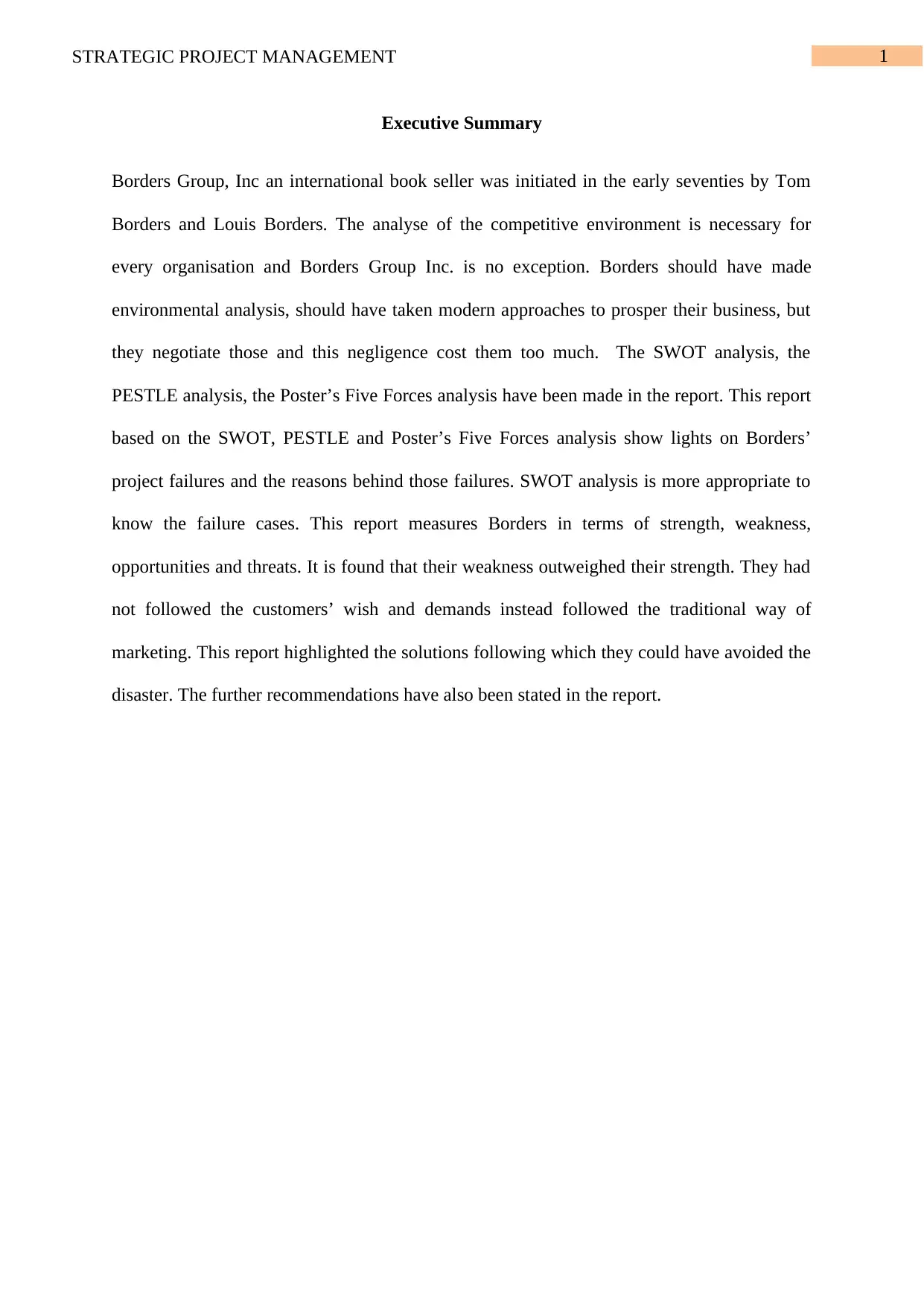
1STRATEGIC PROJECT MANAGEMENT
Executive Summary
Borders Group, Inc an international book seller was initiated in the early seventies by Tom
Borders and Louis Borders. The analyse of the competitive environment is necessary for
every organisation and Borders Group Inc. is no exception. Borders should have made
environmental analysis, should have taken modern approaches to prosper their business, but
they negotiate those and this negligence cost them too much. The SWOT analysis, the
PESTLE analysis, the Poster’s Five Forces analysis have been made in the report. This report
based on the SWOT, PESTLE and Poster’s Five Forces analysis show lights on Borders’
project failures and the reasons behind those failures. SWOT analysis is more appropriate to
know the failure cases. This report measures Borders in terms of strength, weakness,
opportunities and threats. It is found that their weakness outweighed their strength. They had
not followed the customers’ wish and demands instead followed the traditional way of
marketing. This report highlighted the solutions following which they could have avoided the
disaster. The further recommendations have also been stated in the report.
Executive Summary
Borders Group, Inc an international book seller was initiated in the early seventies by Tom
Borders and Louis Borders. The analyse of the competitive environment is necessary for
every organisation and Borders Group Inc. is no exception. Borders should have made
environmental analysis, should have taken modern approaches to prosper their business, but
they negotiate those and this negligence cost them too much. The SWOT analysis, the
PESTLE analysis, the Poster’s Five Forces analysis have been made in the report. This report
based on the SWOT, PESTLE and Poster’s Five Forces analysis show lights on Borders’
project failures and the reasons behind those failures. SWOT analysis is more appropriate to
know the failure cases. This report measures Borders in terms of strength, weakness,
opportunities and threats. It is found that their weakness outweighed their strength. They had
not followed the customers’ wish and demands instead followed the traditional way of
marketing. This report highlighted the solutions following which they could have avoided the
disaster. The further recommendations have also been stated in the report.
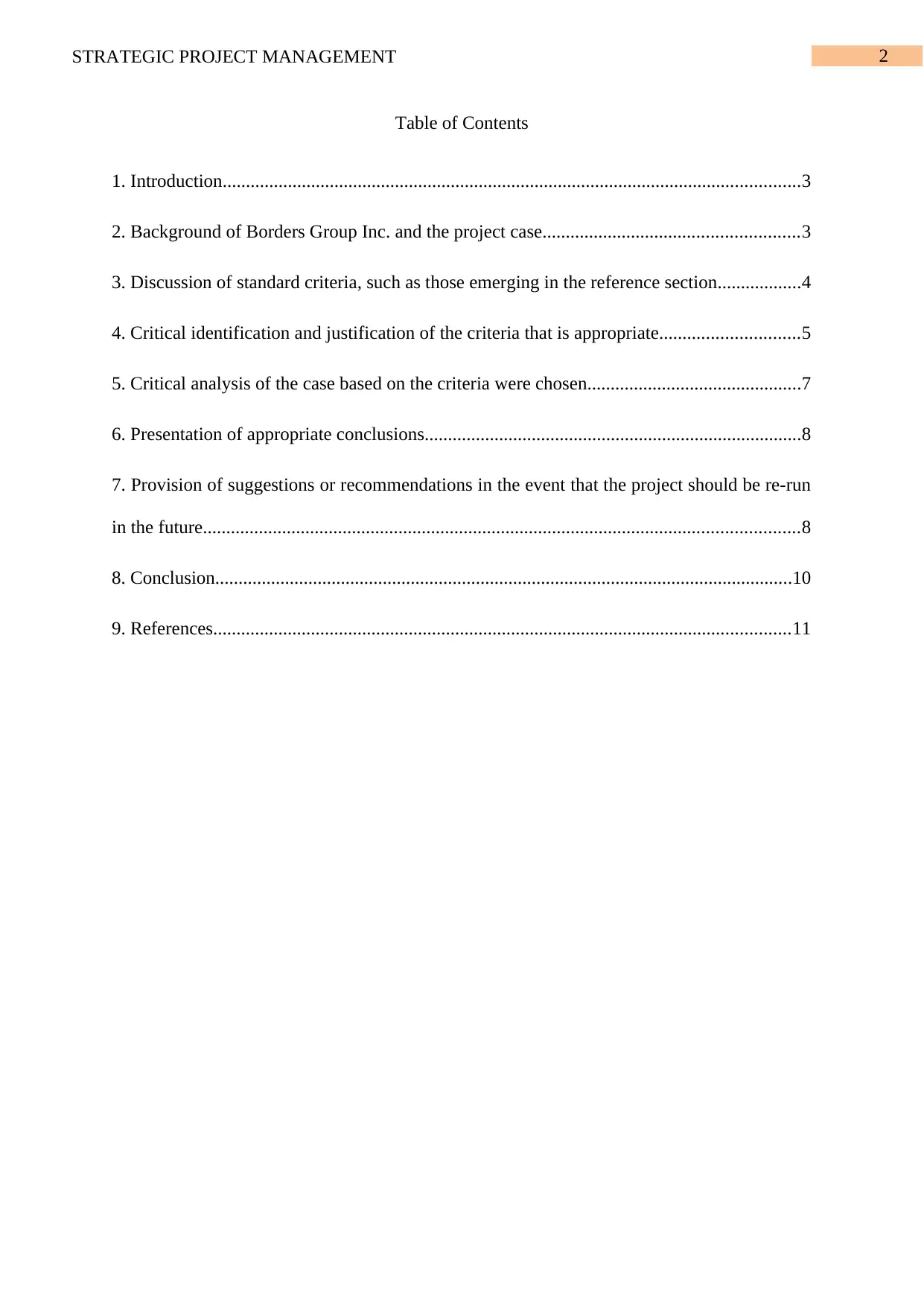
2STRATEGIC PROJECT MANAGEMENT
Table of Contents
1. Introduction............................................................................................................................3
2. Background of Borders Group Inc. and the project case.......................................................3
3. Discussion of standard criteria, such as those emerging in the reference section..................4
4. Critical identification and justification of the criteria that is appropriate..............................5
5. Critical analysis of the case based on the criteria were chosen..............................................7
6. Presentation of appropriate conclusions.................................................................................8
7. Provision of suggestions or recommendations in the event that the project should be re-run
in the future................................................................................................................................8
8. Conclusion............................................................................................................................10
9. References............................................................................................................................11
Table of Contents
1. Introduction............................................................................................................................3
2. Background of Borders Group Inc. and the project case.......................................................3
3. Discussion of standard criteria, such as those emerging in the reference section..................4
4. Critical identification and justification of the criteria that is appropriate..............................5
5. Critical analysis of the case based on the criteria were chosen..............................................7
6. Presentation of appropriate conclusions.................................................................................8
7. Provision of suggestions or recommendations in the event that the project should be re-run
in the future................................................................................................................................8
8. Conclusion............................................................................................................................10
9. References............................................................................................................................11
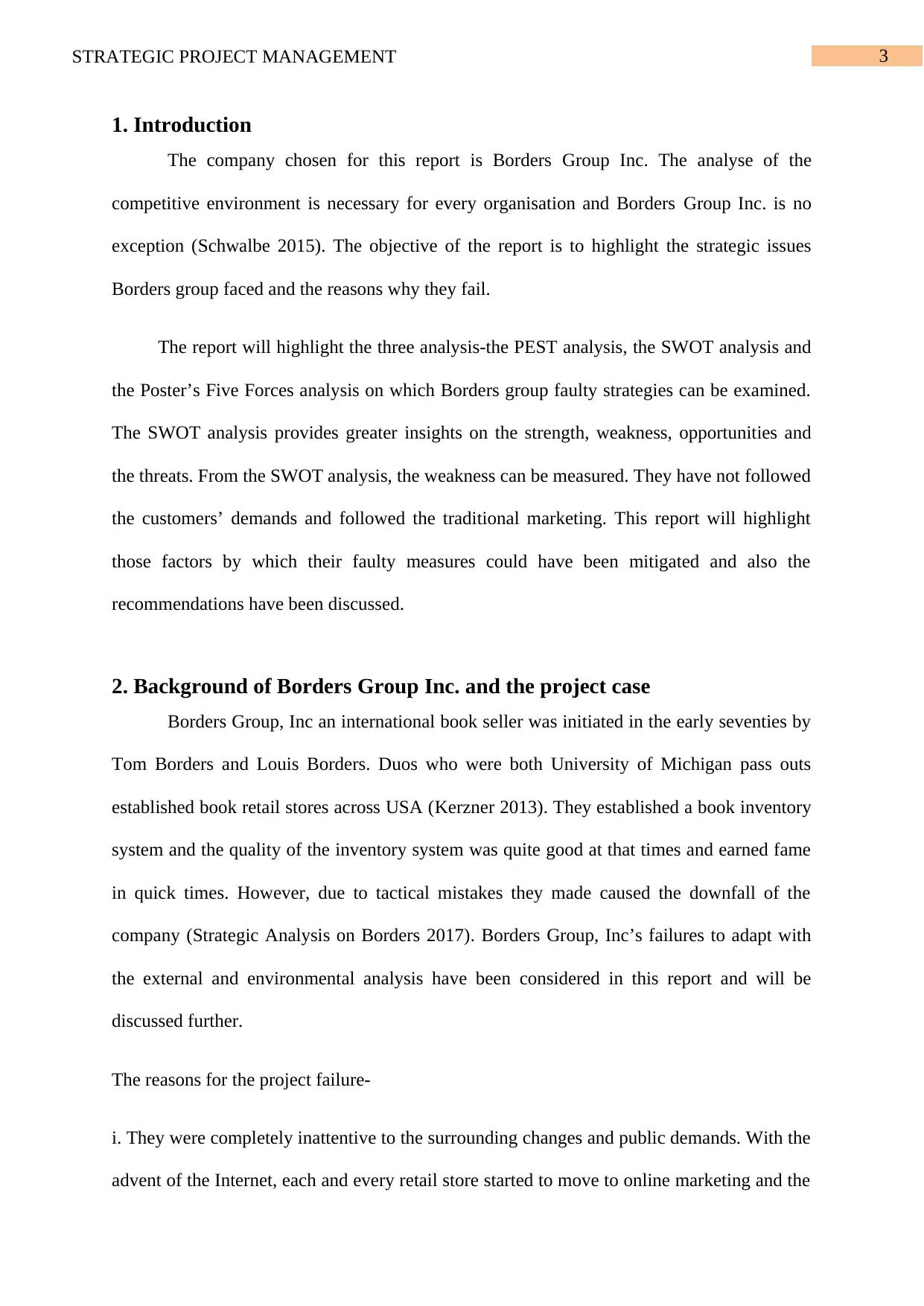
3STRATEGIC PROJECT MANAGEMENT
1. Introduction
The company chosen for this report is Borders Group Inc. The analyse of the
competitive environment is necessary for every organisation and Borders Group Inc. is no
exception (Schwalbe 2015). The objective of the report is to highlight the strategic issues
Borders group faced and the reasons why they fail.
The report will highlight the three analysis-the PEST analysis, the SWOT analysis and
the Poster’s Five Forces analysis on which Borders group faulty strategies can be examined.
The SWOT analysis provides greater insights on the strength, weakness, opportunities and
the threats. From the SWOT analysis, the weakness can be measured. They have not followed
the customers’ demands and followed the traditional marketing. This report will highlight
those factors by which their faulty measures could have been mitigated and also the
recommendations have been discussed.
2. Background of Borders Group Inc. and the project case
Borders Group, Inc an international book seller was initiated in the early seventies by
Tom Borders and Louis Borders. Duos who were both University of Michigan pass outs
established book retail stores across USA (Kerzner 2013). They established a book inventory
system and the quality of the inventory system was quite good at that times and earned fame
in quick times. However, due to tactical mistakes they made caused the downfall of the
company (Strategic Analysis on Borders 2017). Borders Group, Inc’s failures to adapt with
the external and environmental analysis have been considered in this report and will be
discussed further.
The reasons for the project failure-
i. They were completely inattentive to the surrounding changes and public demands. With the
advent of the Internet, each and every retail store started to move to online marketing and the
1. Introduction
The company chosen for this report is Borders Group Inc. The analyse of the
competitive environment is necessary for every organisation and Borders Group Inc. is no
exception (Schwalbe 2015). The objective of the report is to highlight the strategic issues
Borders group faced and the reasons why they fail.
The report will highlight the three analysis-the PEST analysis, the SWOT analysis and
the Poster’s Five Forces analysis on which Borders group faulty strategies can be examined.
The SWOT analysis provides greater insights on the strength, weakness, opportunities and
the threats. From the SWOT analysis, the weakness can be measured. They have not followed
the customers’ demands and followed the traditional marketing. This report will highlight
those factors by which their faulty measures could have been mitigated and also the
recommendations have been discussed.
2. Background of Borders Group Inc. and the project case
Borders Group, Inc an international book seller was initiated in the early seventies by
Tom Borders and Louis Borders. Duos who were both University of Michigan pass outs
established book retail stores across USA (Kerzner 2013). They established a book inventory
system and the quality of the inventory system was quite good at that times and earned fame
in quick times. However, due to tactical mistakes they made caused the downfall of the
company (Strategic Analysis on Borders 2017). Borders Group, Inc’s failures to adapt with
the external and environmental analysis have been considered in this report and will be
discussed further.
The reasons for the project failure-
i. They were completely inattentive to the surrounding changes and public demands. With the
advent of the Internet, each and every retail store started to move to online marketing and the
Secure Best Marks with AI Grader
Need help grading? Try our AI Grader for instant feedback on your assignments.
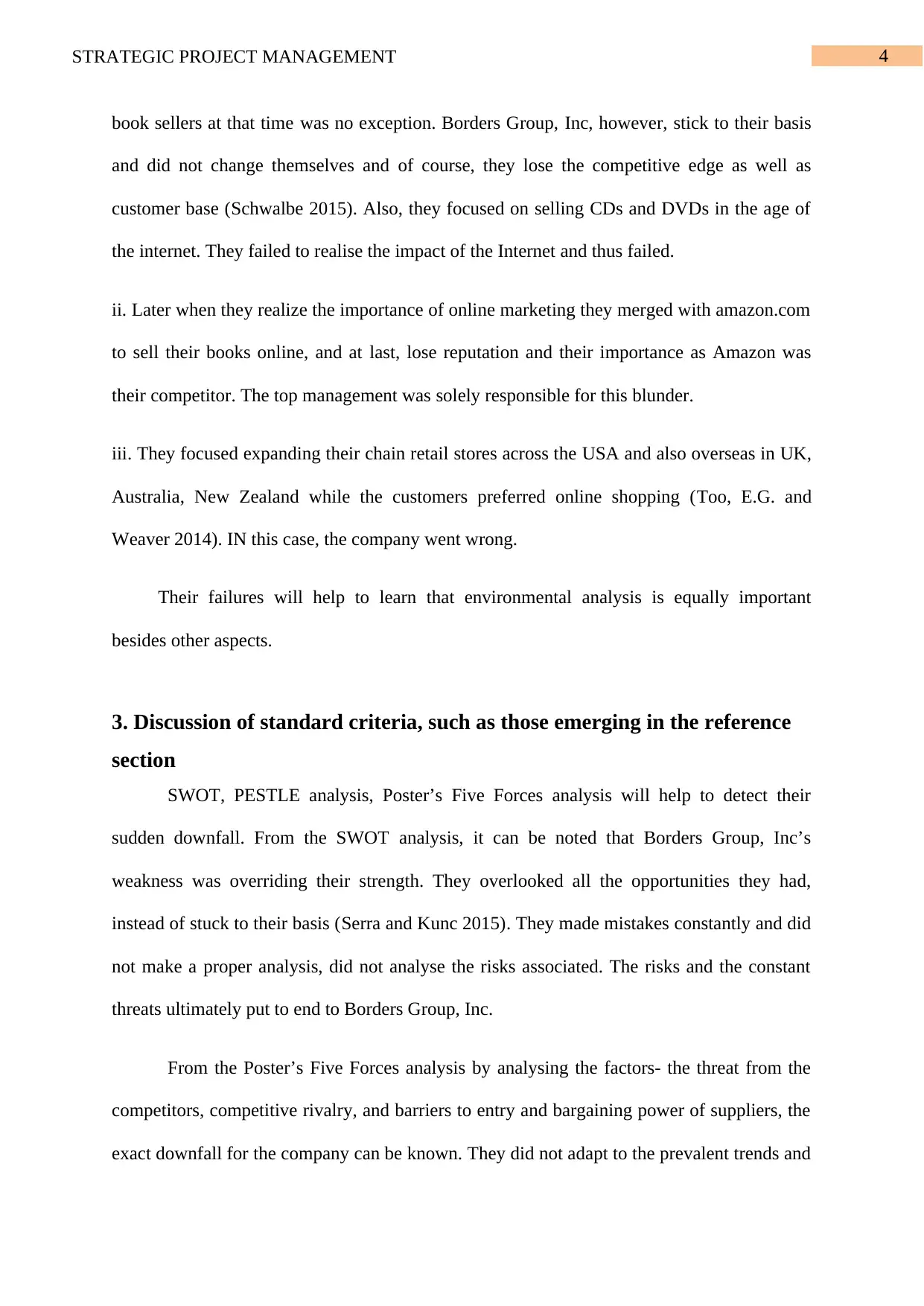
4STRATEGIC PROJECT MANAGEMENT
book sellers at that time was no exception. Borders Group, Inc, however, stick to their basis
and did not change themselves and of course, they lose the competitive edge as well as
customer base (Schwalbe 2015). Also, they focused on selling CDs and DVDs in the age of
the internet. They failed to realise the impact of the Internet and thus failed.
ii. Later when they realize the importance of online marketing they merged with amazon.com
to sell their books online, and at last, lose reputation and their importance as Amazon was
their competitor. The top management was solely responsible for this blunder.
iii. They focused expanding their chain retail stores across the USA and also overseas in UK,
Australia, New Zealand while the customers preferred online shopping (Too, E.G. and
Weaver 2014). IN this case, the company went wrong.
Their failures will help to learn that environmental analysis is equally important
besides other aspects.
3. Discussion of standard criteria, such as those emerging in the reference
section
SWOT, PESTLE analysis, Poster’s Five Forces analysis will help to detect their
sudden downfall. From the SWOT analysis, it can be noted that Borders Group, Inc’s
weakness was overriding their strength. They overlooked all the opportunities they had,
instead of stuck to their basis (Serra and Kunc 2015). They made mistakes constantly and did
not make a proper analysis, did not analyse the risks associated. The risks and the constant
threats ultimately put to end to Borders Group, Inc.
From the Poster’s Five Forces analysis by analysing the factors- the threat from the
competitors, competitive rivalry, and barriers to entry and bargaining power of suppliers, the
exact downfall for the company can be known. They did not adapt to the prevalent trends and
book sellers at that time was no exception. Borders Group, Inc, however, stick to their basis
and did not change themselves and of course, they lose the competitive edge as well as
customer base (Schwalbe 2015). Also, they focused on selling CDs and DVDs in the age of
the internet. They failed to realise the impact of the Internet and thus failed.
ii. Later when they realize the importance of online marketing they merged with amazon.com
to sell their books online, and at last, lose reputation and their importance as Amazon was
their competitor. The top management was solely responsible for this blunder.
iii. They focused expanding their chain retail stores across the USA and also overseas in UK,
Australia, New Zealand while the customers preferred online shopping (Too, E.G. and
Weaver 2014). IN this case, the company went wrong.
Their failures will help to learn that environmental analysis is equally important
besides other aspects.
3. Discussion of standard criteria, such as those emerging in the reference
section
SWOT, PESTLE analysis, Poster’s Five Forces analysis will help to detect their
sudden downfall. From the SWOT analysis, it can be noted that Borders Group, Inc’s
weakness was overriding their strength. They overlooked all the opportunities they had,
instead of stuck to their basis (Serra and Kunc 2015). They made mistakes constantly and did
not make a proper analysis, did not analyse the risks associated. The risks and the constant
threats ultimately put to end to Borders Group, Inc.
From the Poster’s Five Forces analysis by analysing the factors- the threat from the
competitors, competitive rivalry, and barriers to entry and bargaining power of suppliers, the
exact downfall for the company can be known. They did not adapt to the prevalent trends and
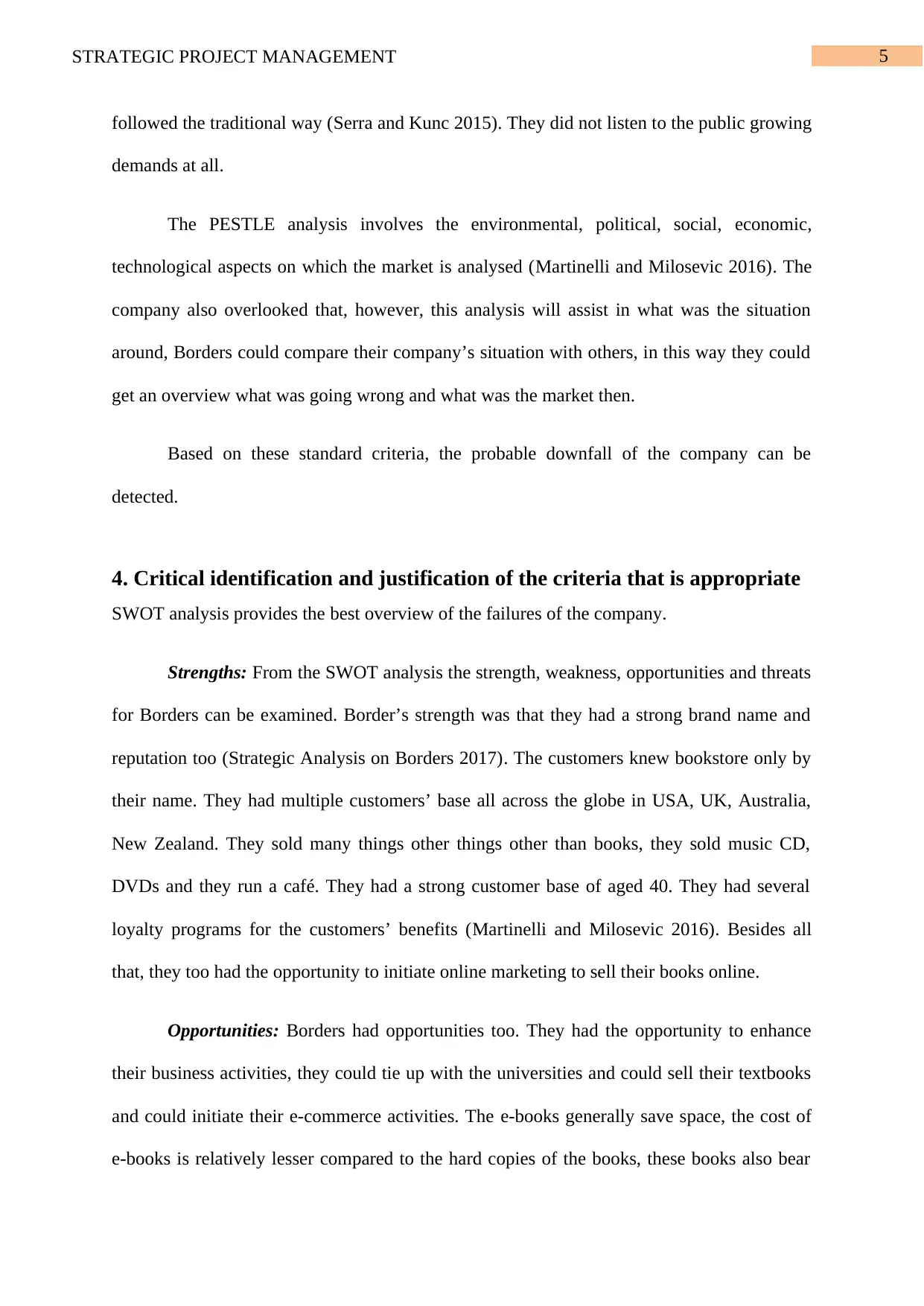
5STRATEGIC PROJECT MANAGEMENT
followed the traditional way (Serra and Kunc 2015). They did not listen to the public growing
demands at all.
The PESTLE analysis involves the environmental, political, social, economic,
technological aspects on which the market is analysed (Martinelli and Milosevic 2016). The
company also overlooked that, however, this analysis will assist in what was the situation
around, Borders could compare their company’s situation with others, in this way they could
get an overview what was going wrong and what was the market then.
Based on these standard criteria, the probable downfall of the company can be
detected.
4. Critical identification and justification of the criteria that is appropriate
SWOT analysis provides the best overview of the failures of the company.
Strengths: From the SWOT analysis the strength, weakness, opportunities and threats
for Borders can be examined. Border’s strength was that they had a strong brand name and
reputation too (Strategic Analysis on Borders 2017). The customers knew bookstore only by
their name. They had multiple customers’ base all across the globe in USA, UK, Australia,
New Zealand. They sold many things other things other than books, they sold music CD,
DVDs and they run a café. They had a strong customer base of aged 40. They had several
loyalty programs for the customers’ benefits (Martinelli and Milosevic 2016). Besides all
that, they too had the opportunity to initiate online marketing to sell their books online.
Opportunities: Borders had opportunities too. They had the opportunity to enhance
their business activities, they could tie up with the universities and could sell their textbooks
and could initiate their e-commerce activities. The e-books generally save space, the cost of
e-books is relatively lesser compared to the hard copies of the books, these books also bear
followed the traditional way (Serra and Kunc 2015). They did not listen to the public growing
demands at all.
The PESTLE analysis involves the environmental, political, social, economic,
technological aspects on which the market is analysed (Martinelli and Milosevic 2016). The
company also overlooked that, however, this analysis will assist in what was the situation
around, Borders could compare their company’s situation with others, in this way they could
get an overview what was going wrong and what was the market then.
Based on these standard criteria, the probable downfall of the company can be
detected.
4. Critical identification and justification of the criteria that is appropriate
SWOT analysis provides the best overview of the failures of the company.
Strengths: From the SWOT analysis the strength, weakness, opportunities and threats
for Borders can be examined. Border’s strength was that they had a strong brand name and
reputation too (Strategic Analysis on Borders 2017). The customers knew bookstore only by
their name. They had multiple customers’ base all across the globe in USA, UK, Australia,
New Zealand. They sold many things other things other than books, they sold music CD,
DVDs and they run a café. They had a strong customer base of aged 40. They had several
loyalty programs for the customers’ benefits (Martinelli and Milosevic 2016). Besides all
that, they too had the opportunity to initiate online marketing to sell their books online.
Opportunities: Borders had opportunities too. They had the opportunity to enhance
their business activities, they could tie up with the universities and could sell their textbooks
and could initiate their e-commerce activities. The e-books generally save space, the cost of
e-books is relatively lesser compared to the hard copies of the books, these books also bear
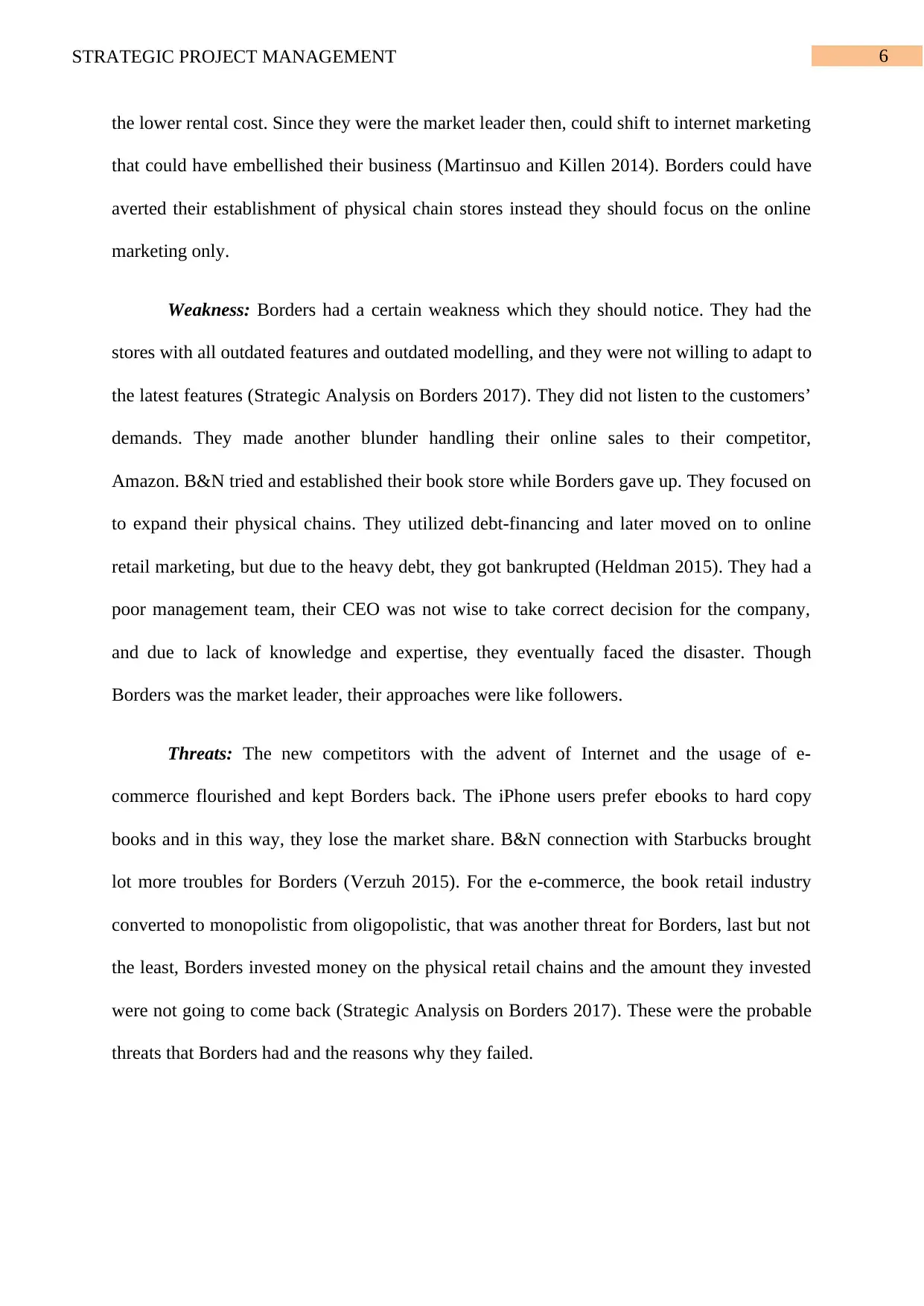
6STRATEGIC PROJECT MANAGEMENT
the lower rental cost. Since they were the market leader then, could shift to internet marketing
that could have embellished their business (Martinsuo and Killen 2014). Borders could have
averted their establishment of physical chain stores instead they should focus on the online
marketing only.
Weakness: Borders had a certain weakness which they should notice. They had the
stores with all outdated features and outdated modelling, and they were not willing to adapt to
the latest features (Strategic Analysis on Borders 2017). They did not listen to the customers’
demands. They made another blunder handling their online sales to their competitor,
Amazon. B&N tried and established their book store while Borders gave up. They focused on
to expand their physical chains. They utilized debt-financing and later moved on to online
retail marketing, but due to the heavy debt, they got bankrupted (Heldman 2015). They had a
poor management team, their CEO was not wise to take correct decision for the company,
and due to lack of knowledge and expertise, they eventually faced the disaster. Though
Borders was the market leader, their approaches were like followers.
Threats: The new competitors with the advent of Internet and the usage of e-
commerce flourished and kept Borders back. The iPhone users prefer ebooks to hard copy
books and in this way, they lose the market share. B&N connection with Starbucks brought
lot more troubles for Borders (Verzuh 2015). For the e-commerce, the book retail industry
converted to monopolistic from oligopolistic, that was another threat for Borders, last but not
the least, Borders invested money on the physical retail chains and the amount they invested
were not going to come back (Strategic Analysis on Borders 2017). These were the probable
threats that Borders had and the reasons why they failed.
the lower rental cost. Since they were the market leader then, could shift to internet marketing
that could have embellished their business (Martinsuo and Killen 2014). Borders could have
averted their establishment of physical chain stores instead they should focus on the online
marketing only.
Weakness: Borders had a certain weakness which they should notice. They had the
stores with all outdated features and outdated modelling, and they were not willing to adapt to
the latest features (Strategic Analysis on Borders 2017). They did not listen to the customers’
demands. They made another blunder handling their online sales to their competitor,
Amazon. B&N tried and established their book store while Borders gave up. They focused on
to expand their physical chains. They utilized debt-financing and later moved on to online
retail marketing, but due to the heavy debt, they got bankrupted (Heldman 2015). They had a
poor management team, their CEO was not wise to take correct decision for the company,
and due to lack of knowledge and expertise, they eventually faced the disaster. Though
Borders was the market leader, their approaches were like followers.
Threats: The new competitors with the advent of Internet and the usage of e-
commerce flourished and kept Borders back. The iPhone users prefer ebooks to hard copy
books and in this way, they lose the market share. B&N connection with Starbucks brought
lot more troubles for Borders (Verzuh 2015). For the e-commerce, the book retail industry
converted to monopolistic from oligopolistic, that was another threat for Borders, last but not
the least, Borders invested money on the physical retail chains and the amount they invested
were not going to come back (Strategic Analysis on Borders 2017). These were the probable
threats that Borders had and the reasons why they failed.
Paraphrase This Document
Need a fresh take? Get an instant paraphrase of this document with our AI Paraphraser
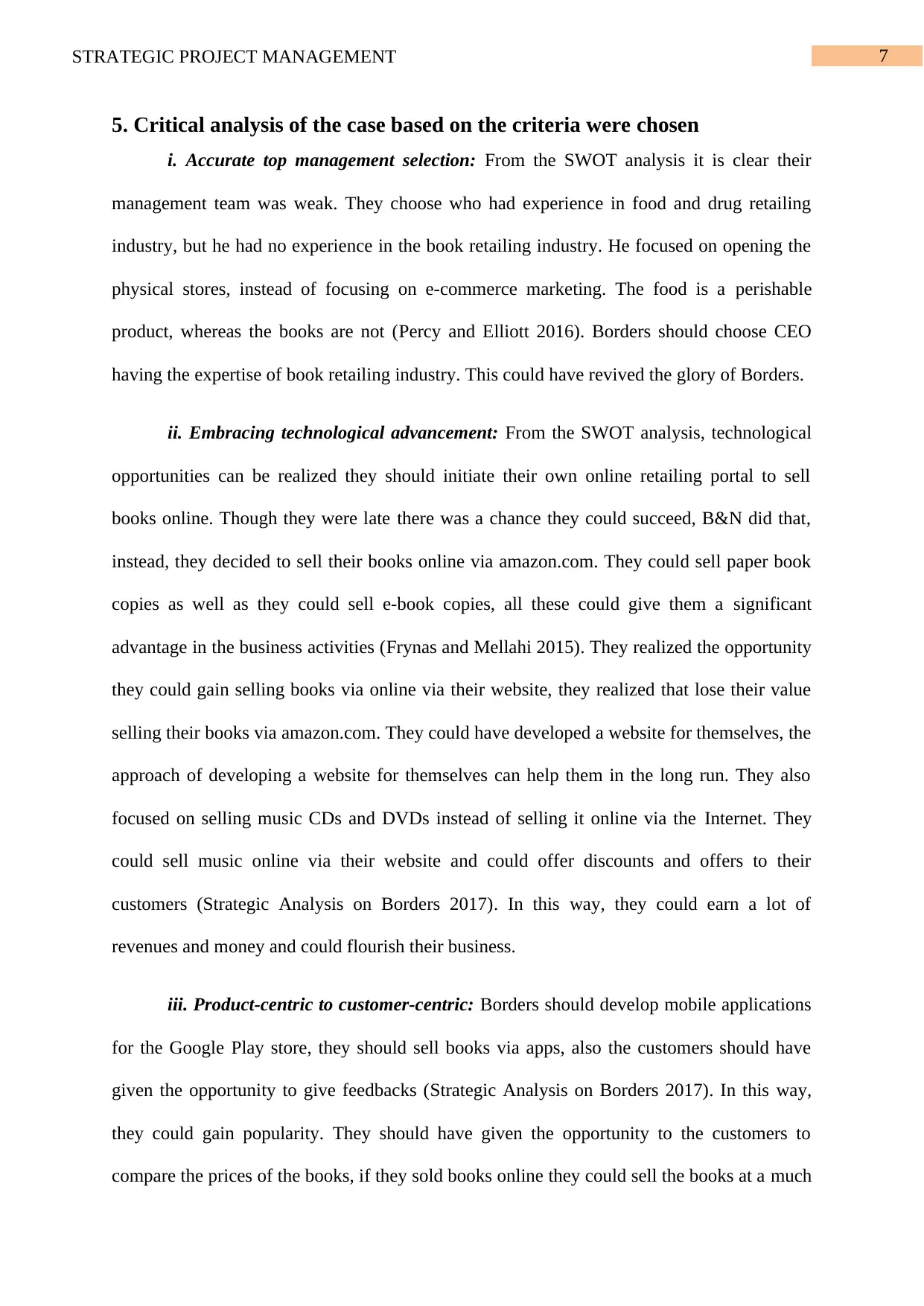
7STRATEGIC PROJECT MANAGEMENT
5. Critical analysis of the case based on the criteria were chosen
i. Accurate top management selection: From the SWOT analysis it is clear their
management team was weak. They choose who had experience in food and drug retailing
industry, but he had no experience in the book retailing industry. He focused on opening the
physical stores, instead of focusing on e-commerce marketing. The food is a perishable
product, whereas the books are not (Percy and Elliott 2016). Borders should choose CEO
having the expertise of book retailing industry. This could have revived the glory of Borders.
ii. Embracing technological advancement: From the SWOT analysis, technological
opportunities can be realized they should initiate their own online retailing portal to sell
books online. Though they were late there was a chance they could succeed, B&N did that,
instead, they decided to sell their books online via amazon.com. They could sell paper book
copies as well as they could sell e-book copies, all these could give them a significant
advantage in the business activities (Frynas and Mellahi 2015). They realized the opportunity
they could gain selling books via online via their website, they realized that lose their value
selling their books via amazon.com. They could have developed a website for themselves, the
approach of developing a website for themselves can help them in the long run. They also
focused on selling music CDs and DVDs instead of selling it online via the Internet. They
could sell music online via their website and could offer discounts and offers to their
customers (Strategic Analysis on Borders 2017). In this way, they could earn a lot of
revenues and money and could flourish their business.
iii. Product-centric to customer-centric: Borders should develop mobile applications
for the Google Play store, they should sell books via apps, also the customers should have
given the opportunity to give feedbacks (Strategic Analysis on Borders 2017). In this way,
they could gain popularity. They should have given the opportunity to the customers to
compare the prices of the books, if they sold books online they could sell the books at a much
5. Critical analysis of the case based on the criteria were chosen
i. Accurate top management selection: From the SWOT analysis it is clear their
management team was weak. They choose who had experience in food and drug retailing
industry, but he had no experience in the book retailing industry. He focused on opening the
physical stores, instead of focusing on e-commerce marketing. The food is a perishable
product, whereas the books are not (Percy and Elliott 2016). Borders should choose CEO
having the expertise of book retailing industry. This could have revived the glory of Borders.
ii. Embracing technological advancement: From the SWOT analysis, technological
opportunities can be realized they should initiate their own online retailing portal to sell
books online. Though they were late there was a chance they could succeed, B&N did that,
instead, they decided to sell their books online via amazon.com. They could sell paper book
copies as well as they could sell e-book copies, all these could give them a significant
advantage in the business activities (Frynas and Mellahi 2015). They realized the opportunity
they could gain selling books via online via their website, they realized that lose their value
selling their books via amazon.com. They could have developed a website for themselves, the
approach of developing a website for themselves can help them in the long run. They also
focused on selling music CDs and DVDs instead of selling it online via the Internet. They
could sell music online via their website and could offer discounts and offers to their
customers (Strategic Analysis on Borders 2017). In this way, they could earn a lot of
revenues and money and could flourish their business.
iii. Product-centric to customer-centric: Borders should develop mobile applications
for the Google Play store, they should sell books via apps, also the customers should have
given the opportunity to give feedbacks (Strategic Analysis on Borders 2017). In this way,
they could gain popularity. They should have given the opportunity to the customers to
compare the prices of the books, if they sold books online they could sell the books at a much
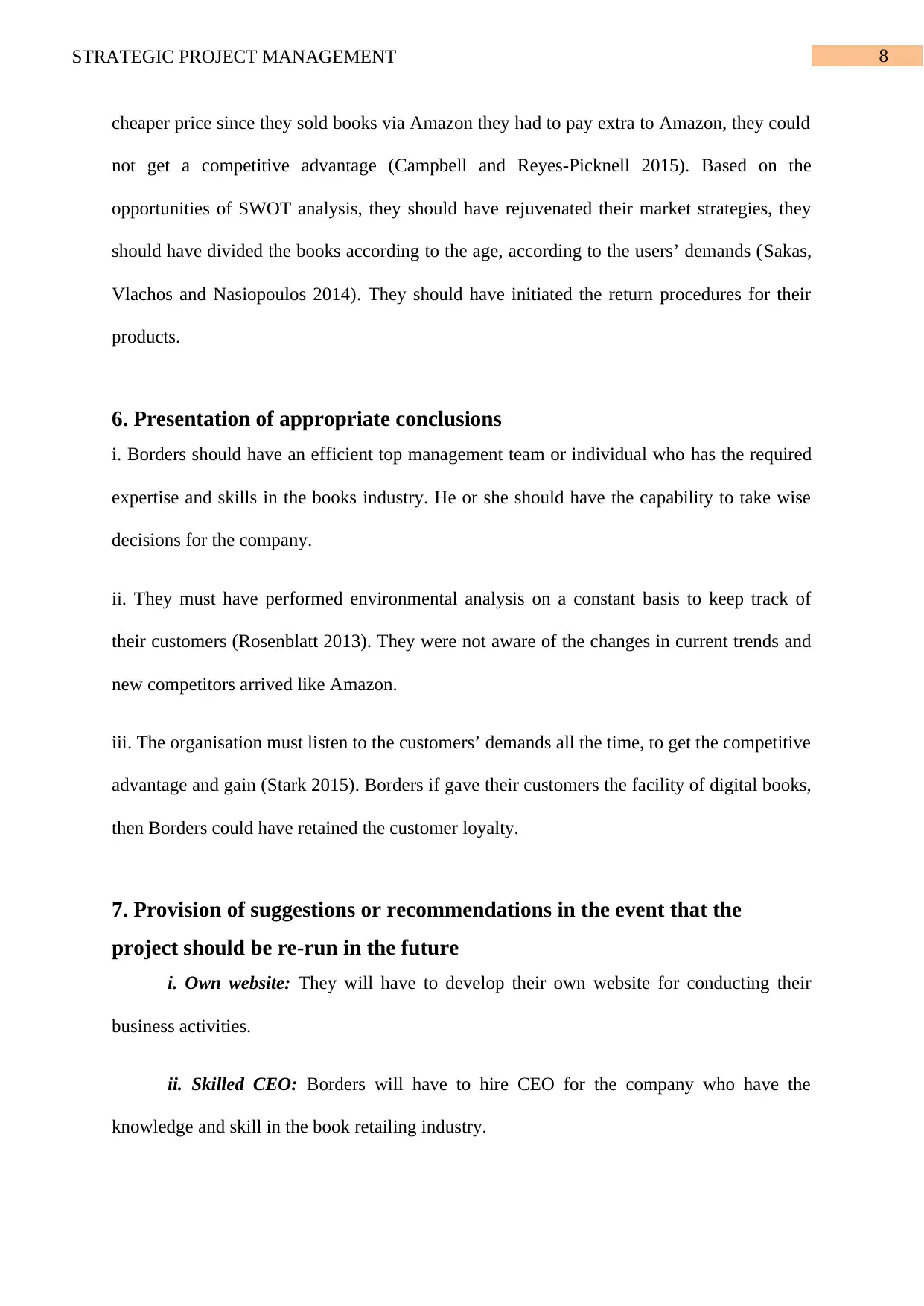
8STRATEGIC PROJECT MANAGEMENT
cheaper price since they sold books via Amazon they had to pay extra to Amazon, they could
not get a competitive advantage (Campbell and Reyes-Picknell 2015). Based on the
opportunities of SWOT analysis, they should have rejuvenated their market strategies, they
should have divided the books according to the age, according to the users’ demands (Sakas,
Vlachos and Nasiopoulos 2014). They should have initiated the return procedures for their
products.
6. Presentation of appropriate conclusions
i. Borders should have an efficient top management team or individual who has the required
expertise and skills in the books industry. He or she should have the capability to take wise
decisions for the company.
ii. They must have performed environmental analysis on a constant basis to keep track of
their customers (Rosenblatt 2013). They were not aware of the changes in current trends and
new competitors arrived like Amazon.
iii. The organisation must listen to the customers’ demands all the time, to get the competitive
advantage and gain (Stark 2015). Borders if gave their customers the facility of digital books,
then Borders could have retained the customer loyalty.
7. Provision of suggestions or recommendations in the event that the
project should be re-run in the future
i. Own website: They will have to develop their own website for conducting their
business activities.
ii. Skilled CEO: Borders will have to hire CEO for the company who have the
knowledge and skill in the book retailing industry.
cheaper price since they sold books via Amazon they had to pay extra to Amazon, they could
not get a competitive advantage (Campbell and Reyes-Picknell 2015). Based on the
opportunities of SWOT analysis, they should have rejuvenated their market strategies, they
should have divided the books according to the age, according to the users’ demands (Sakas,
Vlachos and Nasiopoulos 2014). They should have initiated the return procedures for their
products.
6. Presentation of appropriate conclusions
i. Borders should have an efficient top management team or individual who has the required
expertise and skills in the books industry. He or she should have the capability to take wise
decisions for the company.
ii. They must have performed environmental analysis on a constant basis to keep track of
their customers (Rosenblatt 2013). They were not aware of the changes in current trends and
new competitors arrived like Amazon.
iii. The organisation must listen to the customers’ demands all the time, to get the competitive
advantage and gain (Stark 2015). Borders if gave their customers the facility of digital books,
then Borders could have retained the customer loyalty.
7. Provision of suggestions or recommendations in the event that the
project should be re-run in the future
i. Own website: They will have to develop their own website for conducting their
business activities.
ii. Skilled CEO: Borders will have to hire CEO for the company who have the
knowledge and skill in the book retailing industry.
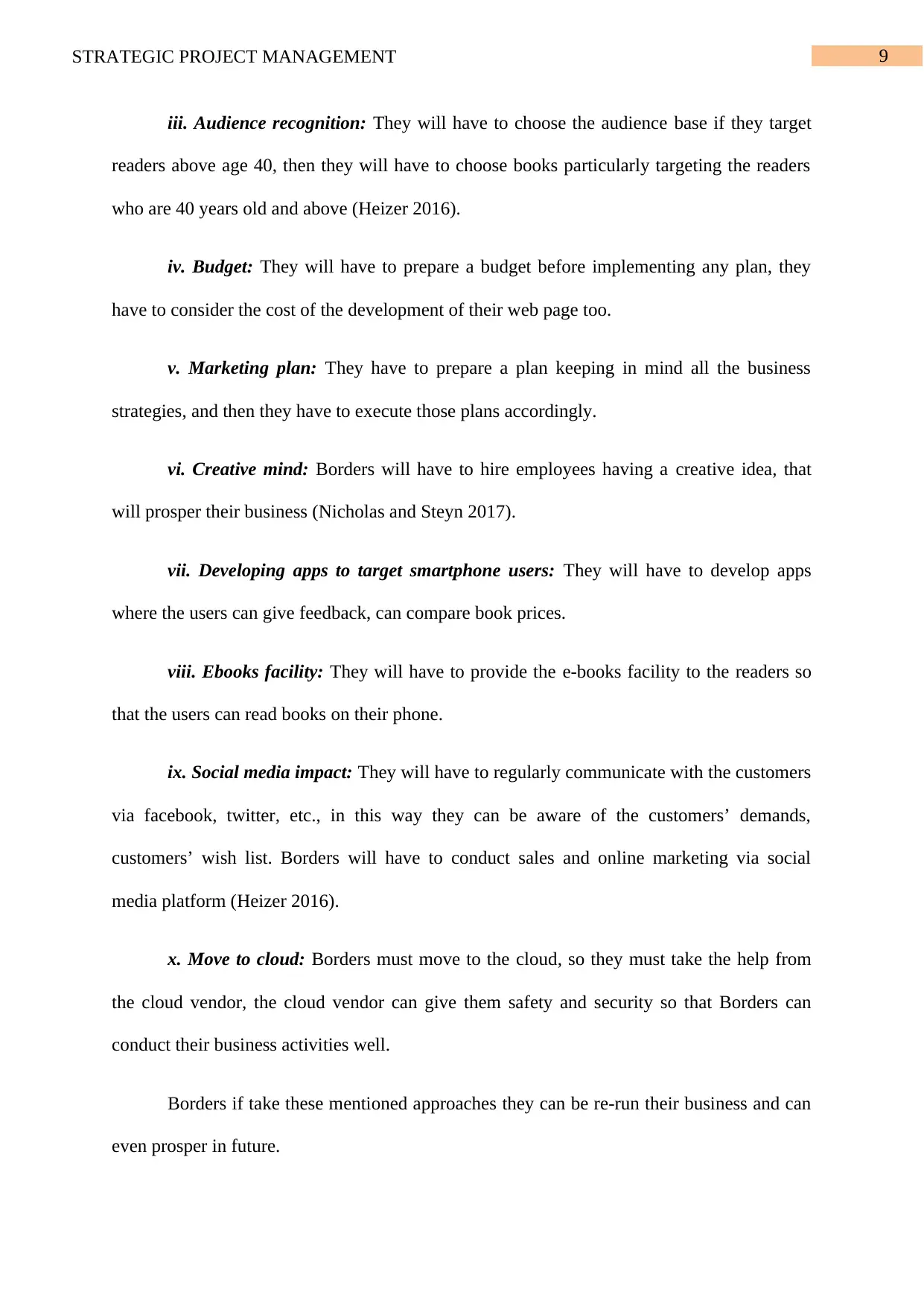
9STRATEGIC PROJECT MANAGEMENT
iii. Audience recognition: They will have to choose the audience base if they target
readers above age 40, then they will have to choose books particularly targeting the readers
who are 40 years old and above (Heizer 2016).
iv. Budget: They will have to prepare a budget before implementing any plan, they
have to consider the cost of the development of their web page too.
v. Marketing plan: They have to prepare a plan keeping in mind all the business
strategies, and then they have to execute those plans accordingly.
vi. Creative mind: Borders will have to hire employees having a creative idea, that
will prosper their business (Nicholas and Steyn 2017).
vii. Developing apps to target smartphone users: They will have to develop apps
where the users can give feedback, can compare book prices.
viii. Ebooks facility: They will have to provide the e-books facility to the readers so
that the users can read books on their phone.
ix. Social media impact: They will have to regularly communicate with the customers
via facebook, twitter, etc., in this way they can be aware of the customers’ demands,
customers’ wish list. Borders will have to conduct sales and online marketing via social
media platform (Heizer 2016).
x. Move to cloud: Borders must move to the cloud, so they must take the help from
the cloud vendor, the cloud vendor can give them safety and security so that Borders can
conduct their business activities well.
Borders if take these mentioned approaches they can be re-run their business and can
even prosper in future.
iii. Audience recognition: They will have to choose the audience base if they target
readers above age 40, then they will have to choose books particularly targeting the readers
who are 40 years old and above (Heizer 2016).
iv. Budget: They will have to prepare a budget before implementing any plan, they
have to consider the cost of the development of their web page too.
v. Marketing plan: They have to prepare a plan keeping in mind all the business
strategies, and then they have to execute those plans accordingly.
vi. Creative mind: Borders will have to hire employees having a creative idea, that
will prosper their business (Nicholas and Steyn 2017).
vii. Developing apps to target smartphone users: They will have to develop apps
where the users can give feedback, can compare book prices.
viii. Ebooks facility: They will have to provide the e-books facility to the readers so
that the users can read books on their phone.
ix. Social media impact: They will have to regularly communicate with the customers
via facebook, twitter, etc., in this way they can be aware of the customers’ demands,
customers’ wish list. Borders will have to conduct sales and online marketing via social
media platform (Heizer 2016).
x. Move to cloud: Borders must move to the cloud, so they must take the help from
the cloud vendor, the cloud vendor can give them safety and security so that Borders can
conduct their business activities well.
Borders if take these mentioned approaches they can be re-run their business and can
even prosper in future.
Secure Best Marks with AI Grader
Need help grading? Try our AI Grader for instant feedback on your assignments.
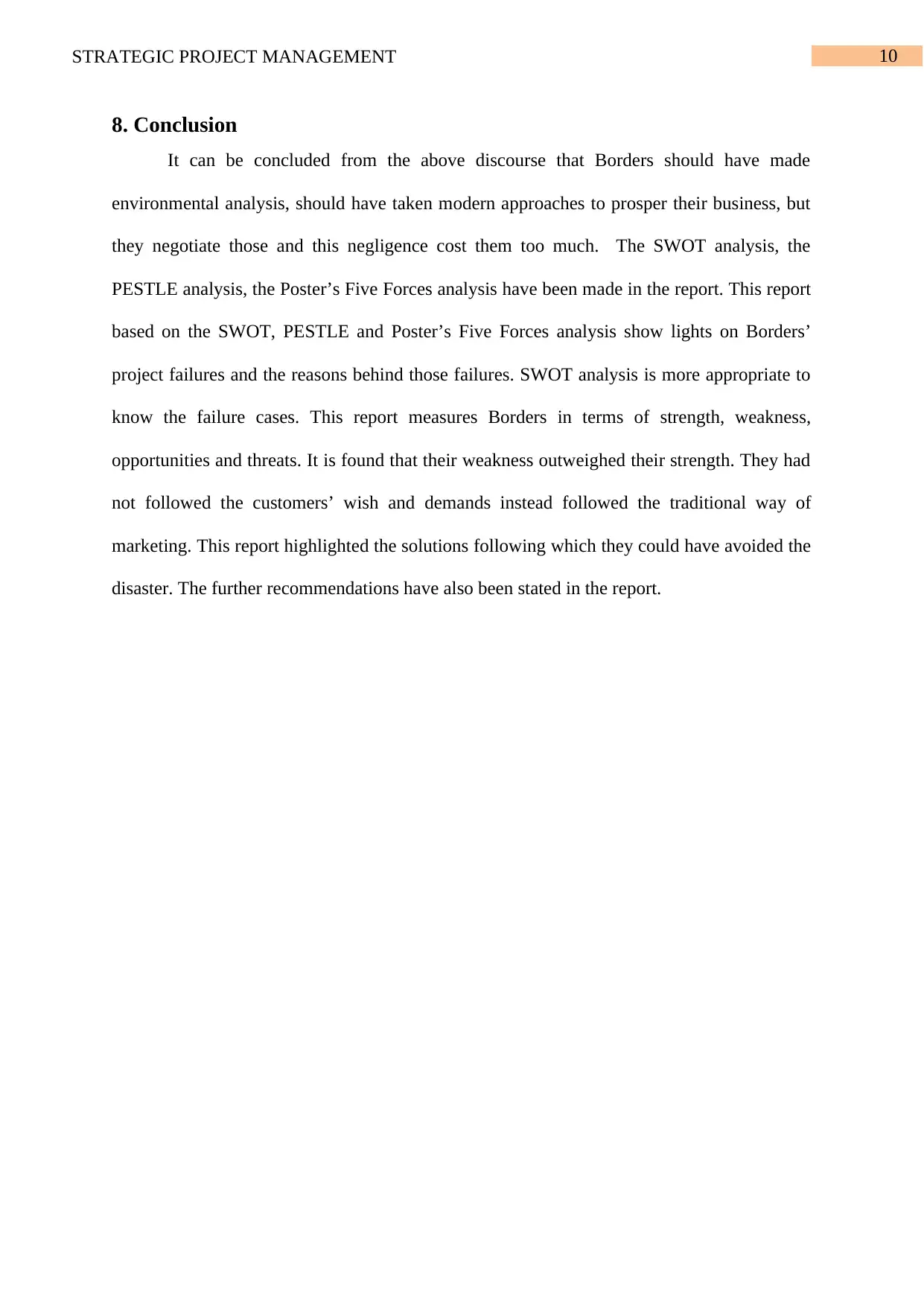
10STRATEGIC PROJECT MANAGEMENT
8. Conclusion
It can be concluded from the above discourse that Borders should have made
environmental analysis, should have taken modern approaches to prosper their business, but
they negotiate those and this negligence cost them too much. The SWOT analysis, the
PESTLE analysis, the Poster’s Five Forces analysis have been made in the report. This report
based on the SWOT, PESTLE and Poster’s Five Forces analysis show lights on Borders’
project failures and the reasons behind those failures. SWOT analysis is more appropriate to
know the failure cases. This report measures Borders in terms of strength, weakness,
opportunities and threats. It is found that their weakness outweighed their strength. They had
not followed the customers’ wish and demands instead followed the traditional way of
marketing. This report highlighted the solutions following which they could have avoided the
disaster. The further recommendations have also been stated in the report.
8. Conclusion
It can be concluded from the above discourse that Borders should have made
environmental analysis, should have taken modern approaches to prosper their business, but
they negotiate those and this negligence cost them too much. The SWOT analysis, the
PESTLE analysis, the Poster’s Five Forces analysis have been made in the report. This report
based on the SWOT, PESTLE and Poster’s Five Forces analysis show lights on Borders’
project failures and the reasons behind those failures. SWOT analysis is more appropriate to
know the failure cases. This report measures Borders in terms of strength, weakness,
opportunities and threats. It is found that their weakness outweighed their strength. They had
not followed the customers’ wish and demands instead followed the traditional way of
marketing. This report highlighted the solutions following which they could have avoided the
disaster. The further recommendations have also been stated in the report.
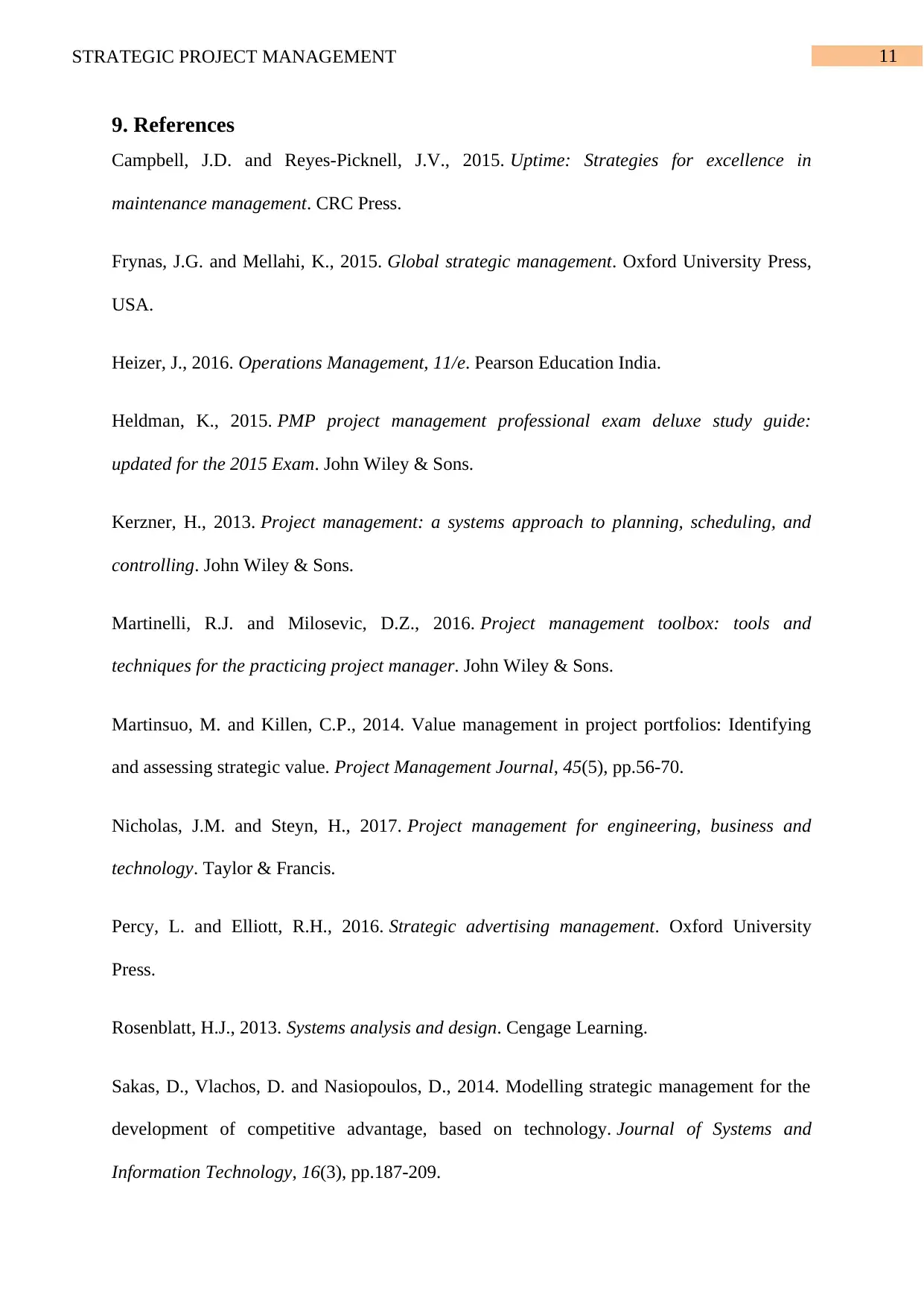
11STRATEGIC PROJECT MANAGEMENT
9. References
Campbell, J.D. and Reyes-Picknell, J.V., 2015. Uptime: Strategies for excellence in
maintenance management. CRC Press.
Frynas, J.G. and Mellahi, K., 2015. Global strategic management. Oxford University Press,
USA.
Heizer, J., 2016. Operations Management, 11/e. Pearson Education India.
Heldman, K., 2015. PMP project management professional exam deluxe study guide:
updated for the 2015 Exam. John Wiley & Sons.
Kerzner, H., 2013. Project management: a systems approach to planning, scheduling, and
controlling. John Wiley & Sons.
Martinelli, R.J. and Milosevic, D.Z., 2016. Project management toolbox: tools and
techniques for the practicing project manager. John Wiley & Sons.
Martinsuo, M. and Killen, C.P., 2014. Value management in project portfolios: Identifying
and assessing strategic value. Project Management Journal, 45(5), pp.56-70.
Nicholas, J.M. and Steyn, H., 2017. Project management for engineering, business and
technology. Taylor & Francis.
Percy, L. and Elliott, R.H., 2016. Strategic advertising management. Oxford University
Press.
Rosenblatt, H.J., 2013. Systems analysis and design. Cengage Learning.
Sakas, D., Vlachos, D. and Nasiopoulos, D., 2014. Modelling strategic management for the
development of competitive advantage, based on technology. Journal of Systems and
Information Technology, 16(3), pp.187-209.
9. References
Campbell, J.D. and Reyes-Picknell, J.V., 2015. Uptime: Strategies for excellence in
maintenance management. CRC Press.
Frynas, J.G. and Mellahi, K., 2015. Global strategic management. Oxford University Press,
USA.
Heizer, J., 2016. Operations Management, 11/e. Pearson Education India.
Heldman, K., 2015. PMP project management professional exam deluxe study guide:
updated for the 2015 Exam. John Wiley & Sons.
Kerzner, H., 2013. Project management: a systems approach to planning, scheduling, and
controlling. John Wiley & Sons.
Martinelli, R.J. and Milosevic, D.Z., 2016. Project management toolbox: tools and
techniques for the practicing project manager. John Wiley & Sons.
Martinsuo, M. and Killen, C.P., 2014. Value management in project portfolios: Identifying
and assessing strategic value. Project Management Journal, 45(5), pp.56-70.
Nicholas, J.M. and Steyn, H., 2017. Project management for engineering, business and
technology. Taylor & Francis.
Percy, L. and Elliott, R.H., 2016. Strategic advertising management. Oxford University
Press.
Rosenblatt, H.J., 2013. Systems analysis and design. Cengage Learning.
Sakas, D., Vlachos, D. and Nasiopoulos, D., 2014. Modelling strategic management for the
development of competitive advantage, based on technology. Journal of Systems and
Information Technology, 16(3), pp.187-209.
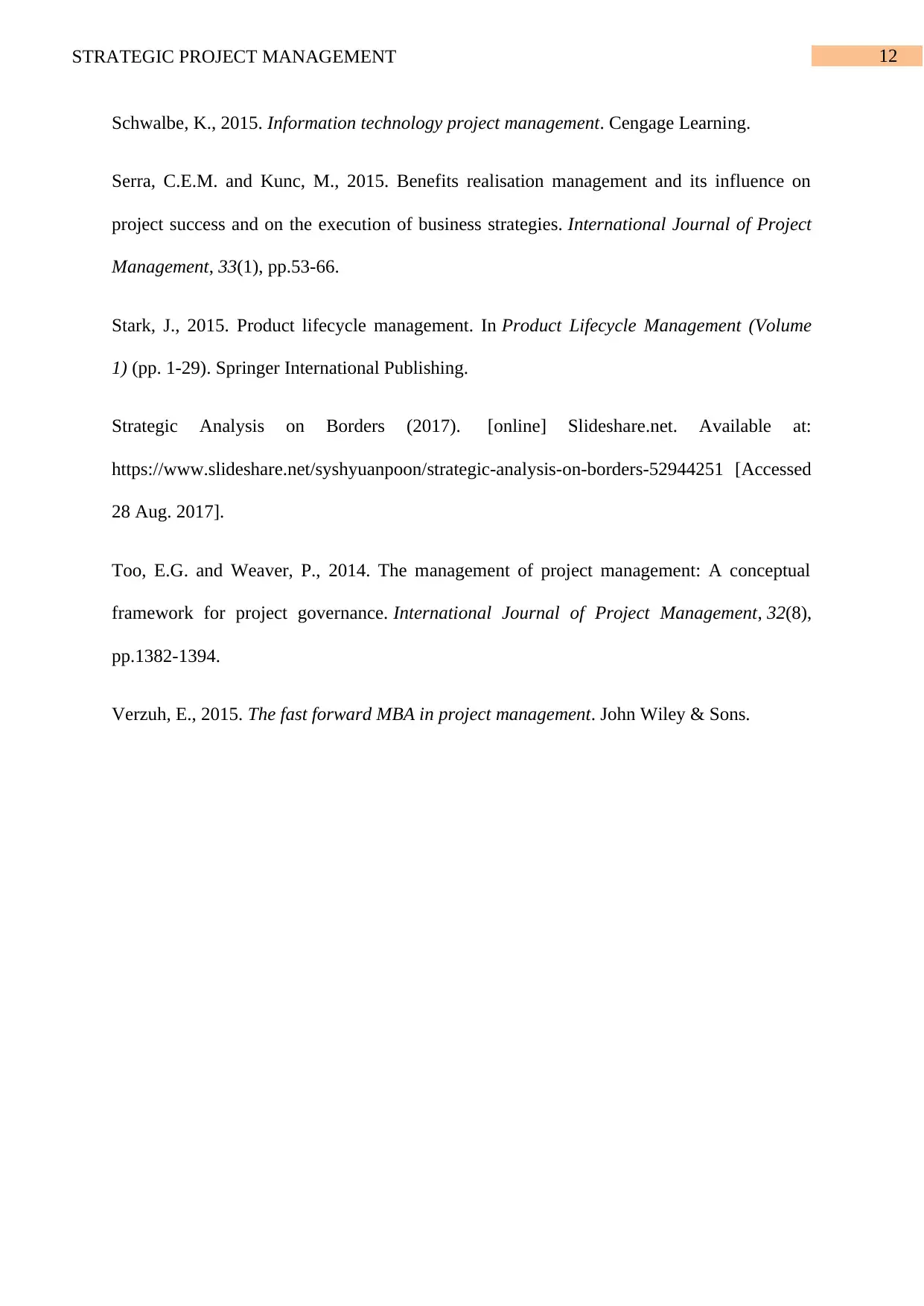
12STRATEGIC PROJECT MANAGEMENT
Schwalbe, K., 2015. Information technology project management. Cengage Learning.
Serra, C.E.M. and Kunc, M., 2015. Benefits realisation management and its influence on
project success and on the execution of business strategies. International Journal of Project
Management, 33(1), pp.53-66.
Stark, J., 2015. Product lifecycle management. In Product Lifecycle Management (Volume
1) (pp. 1-29). Springer International Publishing.
Strategic Analysis on Borders (2017). [online] Slideshare.net. Available at:
https://www.slideshare.net/syshyuanpoon/strategic-analysis-on-borders-52944251 [Accessed
28 Aug. 2017].
Too, E.G. and Weaver, P., 2014. The management of project management: A conceptual
framework for project governance. International Journal of Project Management, 32(8),
pp.1382-1394.
Verzuh, E., 2015. The fast forward MBA in project management. John Wiley & Sons.
Schwalbe, K., 2015. Information technology project management. Cengage Learning.
Serra, C.E.M. and Kunc, M., 2015. Benefits realisation management and its influence on
project success and on the execution of business strategies. International Journal of Project
Management, 33(1), pp.53-66.
Stark, J., 2015. Product lifecycle management. In Product Lifecycle Management (Volume
1) (pp. 1-29). Springer International Publishing.
Strategic Analysis on Borders (2017). [online] Slideshare.net. Available at:
https://www.slideshare.net/syshyuanpoon/strategic-analysis-on-borders-52944251 [Accessed
28 Aug. 2017].
Too, E.G. and Weaver, P., 2014. The management of project management: A conceptual
framework for project governance. International Journal of Project Management, 32(8),
pp.1382-1394.
Verzuh, E., 2015. The fast forward MBA in project management. John Wiley & Sons.
1 out of 13
Related Documents
Your All-in-One AI-Powered Toolkit for Academic Success.
+13062052269
info@desklib.com
Available 24*7 on WhatsApp / Email
![[object Object]](/_next/static/media/star-bottom.7253800d.svg)
Unlock your academic potential
© 2024 | Zucol Services PVT LTD | All rights reserved.





